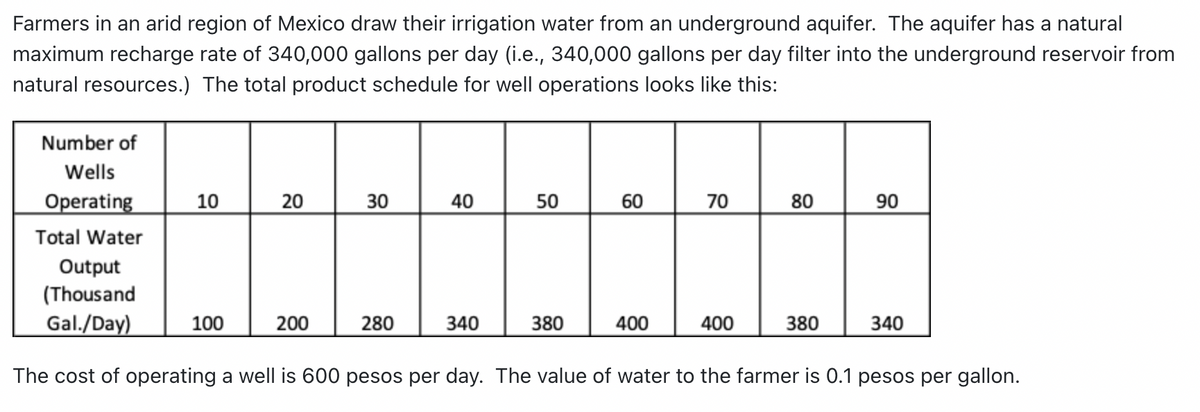(a) What would be the economically efficient number of wells? (Solve to the nearest multiple 10 wells.) Explain why social benefits (profits) are maximized at this level of output. [Hint: Calculate the total revenue and marginal revenue for each number of wells.] (b) If each well is privately owned by a different farmer without any regulations, how many wells will operate? (Solve to the nearest multiple 10 wells, or for example, you could say between 10 and 20 wells.) Is this number of wells economically efficiency? Also, is this number of wells ecologically sustainable in the long-term? [Hint: Calculate the average revenue for each number of wells.]e (c) Suppose a new technology is adapted that reduces the cost of operating a well from 600 to 400 pesos. Now what is socially efficient (i.e. profit maximizing) number of wells with the new technology? How has the introduction of this new technology affected environmental sustainability?
(a) What would be the economically efficient number of wells? (Solve to the nearest multiple 10 wells.) Explain why social benefits (profits) are maximized at this level of output. [Hint: Calculate the total revenue and marginal revenue for each number of wells.] (b) If each well is privately owned by a different farmer without any regulations, how many wells will operate? (Solve to the nearest multiple 10 wells, or for example, you could say between 10 and 20 wells.) Is this number of wells economically efficiency? Also, is this number of wells ecologically sustainable in the long-term? [Hint: Calculate the average revenue for each number of wells.]e (c) Suppose a new technology is adapted that reduces the cost of operating a well from 600 to 400 pesos. Now what is socially efficient (i.e. profit maximizing) number of wells with the new technology? How has the introduction of this new technology affected environmental sustainability?
Chapter1: Making Economics Decisions
Section: Chapter Questions
Problem 1QTC
Related questions
Question
![(a) What would be the economically efficient number of wells? (Solve to the
nearest multiple 10 wells.) Explain why social benefits (profits) are maximized at
this level of output. [Hint: Calculate the total revenue and marginal revenue for
each number of wells.]
(b) If each well is privately owned by a different farmer without any regulations,
how many wells will operate? (Solve to the nearest multiple 10 wells, or for
example, you could say between 10 and 20 wells.) Is this number of wells
economically efficiency? Also, is this number of wells ecologically sustainable in
the long-term? [Hint: Calculate the average revenue for each number of wells.]e
(c) Suppose a new technology is adapted that reduces the cost of operating a
well from 600 to 400 pesos. Now what is socially efficient (i.e. profit maximizing)
number of wells with the new technology? How has the introduction of this new
technology affected environmental sustainability?H](/v2/_next/image?url=https%3A%2F%2Fcontent.bartleby.com%2Fqna-images%2Fquestion%2Fc9328fd8-550c-4b22-b6b1-90c558adad7f%2F4d70903f-7469-41c2-8e7e-cd8d16b8b66f%2Fnkx97w_processed.png&w=3840&q=75)
Transcribed Image Text:(a) What would be the economically efficient number of wells? (Solve to the
nearest multiple 10 wells.) Explain why social benefits (profits) are maximized at
this level of output. [Hint: Calculate the total revenue and marginal revenue for
each number of wells.]
(b) If each well is privately owned by a different farmer without any regulations,
how many wells will operate? (Solve to the nearest multiple 10 wells, or for
example, you could say between 10 and 20 wells.) Is this number of wells
economically efficiency? Also, is this number of wells ecologically sustainable in
the long-term? [Hint: Calculate the average revenue for each number of wells.]e
(c) Suppose a new technology is adapted that reduces the cost of operating a
well from 600 to 400 pesos. Now what is socially efficient (i.e. profit maximizing)
number of wells with the new technology? How has the introduction of this new
technology affected environmental sustainability?H

Transcribed Image Text:Farmers in an arid region of Mexico draw their irrigation water from an underground aquifer. The aquifer has a natural
maximum recharge rate of 340,000 gallons per day (i.e., 340,000 gallons per day filter into the underground reservoir from
natural resources.) The total product schedule for well operations looks like this:
Number of
Wells
Operating
10
20
30
40
50
60
70
80
06
Total Water
Output
(Thousand
Gal./Day)
100
200
280
340
380
400
400
380
340
The cost of operating a well is 600 pesos per day. The value of water to the farmer is 0.1 pesos per gallon.
Expert Solution
This question has been solved!
Explore an expertly crafted, step-by-step solution for a thorough understanding of key concepts.
This is a popular solution!
Trending now
This is a popular solution!
Step by step
Solved in 3 steps with 1 images

Follow-up Questions
Read through expert solutions to related follow-up questions below.
Follow-up Question
(c) Indicate a (license) fee, in pesos per day, that the government could charge to achieve the socially efficient (i.e. profit maximizing) number of wells.
Solution
Knowledge Booster
Learn more about
Need a deep-dive on the concept behind this application? Look no further. Learn more about this topic, economics and related others by exploring similar questions and additional content below.Recommended textbooks for you


Principles of Economics (12th Edition)
Economics
ISBN:
9780134078779
Author:
Karl E. Case, Ray C. Fair, Sharon E. Oster
Publisher:
PEARSON

Engineering Economy (17th Edition)
Economics
ISBN:
9780134870069
Author:
William G. Sullivan, Elin M. Wicks, C. Patrick Koelling
Publisher:
PEARSON


Principles of Economics (12th Edition)
Economics
ISBN:
9780134078779
Author:
Karl E. Case, Ray C. Fair, Sharon E. Oster
Publisher:
PEARSON

Engineering Economy (17th Edition)
Economics
ISBN:
9780134870069
Author:
William G. Sullivan, Elin M. Wicks, C. Patrick Koelling
Publisher:
PEARSON

Principles of Economics (MindTap Course List)
Economics
ISBN:
9781305585126
Author:
N. Gregory Mankiw
Publisher:
Cengage Learning

Managerial Economics: A Problem Solving Approach
Economics
ISBN:
9781337106665
Author:
Luke M. Froeb, Brian T. McCann, Michael R. Ward, Mike Shor
Publisher:
Cengage Learning

Managerial Economics & Business Strategy (Mcgraw-…
Economics
ISBN:
9781259290619
Author:
Michael Baye, Jeff Prince
Publisher:
McGraw-Hill Education